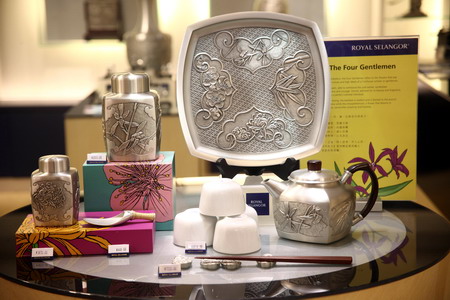Companies
Pewter maker seeks growth in China
By Wang Zhuoqiong (China Daily)
Updated: 2011-04-11 10:52
 |
Large Medium Small |
|
 |
|
A Royal Selangor pewter tea set named "Four gentlemen", inspired by the symbolism of plum blossom, orchid, chrysanthemum and bamboo - considered to be the embodiment of the virtues and high ideas of a Confucian scholar or gentleman - on display at a shop in China. [Photo / China Daily] |
Malaysian business keen to cash in on nation's gift-giving traditional values with exotic designs
BEIJING - To pick an ideal gift for friends and families can be a headache. But Carat Cai had found something that always works well at celebrations or other gatherings.
Three years ago, on a work trip to Singapore, Cai by chance discovered a small container made of pewter and designed for storing youngsters' milk teeth once they drop out.
| ||||
"A gift made from an expensive metal can be too formal for a friend. But a mug or photo frame made in pewter can be unique and interesting," she said.
Cai is among many customers who have developed an interest in luxury giftware made from pewter, a material that is not as valuable as gold and silver but is nonetheless appealing to high-end luxury customers. It is a malleable alloy traditionally made up of 85 to 99 percent tin and the remainder consisting of copper, antimony, lead and bismuth.
Chen Tien-Yue, general manager of Royal Selangor, said the cost of materials is one factor that matters. Other elements - from craftsmanship, design to branding - also determine the value of an item.
"If you look at the high-end brands of giftware, you not only find items in gold and silver, but also in ceramics, glass and crystal, because they reveal great craftsmanship, designs or brands," said Chen, during a recent visit to Beijing from the company's headquarter in Kuala Lumpur.
Now exporting to more than 20 economies, the pewter and silver luxury gift maker has opened retail stores in Singapore, Japan, Hong Kong, the Chinese mainland and Australia.
The market in China is one of the most promising because the gift-giving culture is deeply rooted in society, Chen said.
"China has a real culture of gift-giving, no matter whether it's an individual or business," he said. "It is a much stronger culture than that in the United Kingdom or United States, where gift giving is not considered to be good practice in the world of business."
Royal Selangor's last financial year, that ended in June, reported growth of 50 percent, and the momentum is expected to continue, said Chen. "Luxury brands generally do very well in China and they will continue to grow very fast."
Pointing at a life-size silver peacock displayed in the boutique store in Beijing, Chen said it reflected an interesting feature of the Chinese market - a passion for limited edition products.
"We only have two peacocks in all our markets, one in Beijing and one in London, because Chinese customers like something pretty unique."
In terms of design, Chinese customers also look for cultural relevance, a perfect mixture of heritage, culture and modern lifestyle, Chen said. For instance, Royal Selangor has adopted the traditional Chinese culture of the five elements - fire, water, wind, earth and wood - into its designs, receiving a warm welcome from its Chinese customers.
Chen said recent record high commodity prices that pushed silver to about $35 an ounce and tin to $33 a metric ton also altered the price and designs of his products.
"I've never seen prices that high," he said. "It is a big challenge for us."
The soaring cost has driven the gift maker to increase the prices of products and also obliged it to use materials less susceptible to rises, such as glass.
"It means we might use less pewter in a wine item but the price will not fluctuate so much," he said. "That is the general direction of our new product design."
In China, the company has mainly operated in department store concessions, with more than 20 in 15 cities. In addition it has two retail stores, in Shanghai and Beijing.
"There are lots of brands competing for the same retail location with whatever it takes," he said. "But while we are optimistic about the Chinese market, we have to be cautious on how quickly we open our retail stores."
Chen said the business of giftware has always been a smaller market with much slower growth when compared with luxury accessories and fashion. "We are realistic about the growth. If you look at other gift brands, they will also be more careful on how fast they go," he said.
Despite the size of the market, a gift brand with a long history will be more competitive than those that have been around less time.
The Royal Selangor story started in a small shop in Kuala Lumpur 125 years ago. A young pewtersmith named Yong Koon sailed from the Chinese port of Shantou to Malaysia and began making pewter items in the capital. His business later becomes the world's leading pewter gift brand with a workforce of more than 300 skilled craftsmen.
In 1993, the company acquired one of the oldest and most prestigious silversmith manufacturer, Comyns, an old English brand that can be traced back 350 years.
"Without that story of starting 100 years ago, without the team of experienced craftsmen, it is hard to become a successful gift brand," said Chen.
Taking a heritage brand, telling the story of that heritage and making brands relevant to today's lifestyles allow customers to be more open to the idea of a brand, Chen added.
| 分享按钮 |



